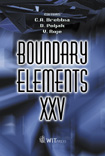Comparison Of The Performance Of Two Error Indicators For 2-D Elastostatic Problems
Price
Free (open access)
Transaction
Volume
35
Pages
10
Published
2003
Size
477.68 kb
Paper DOI
10.2495/BE030061
Copyright
WIT Press
Author(s)
K. H. Muci-Küchler & J. C. Miranda-Valenzuela
Abstract
Comparison of the performance of two error indicators for 2-D elastostatic problems K. H. ~ u c i - ~ i i c h l e r l & J. C. ~iranda-valenzuela2 '~echanical Engineering Department, South Dakota School of Mines and Technology, USA 2 Departamento de Ingenieria Meccinica, ITESM - Campus Toluca, Mexico Abstract The application of adaptive meshing techniques for the design of mechanical components is gaining increased importance in industry. Nowadays many companies are following structured product development methodologies that involve the evaluation of several alternative product concepts in a short amount of time. Under these circumstances, product design engineers are faced with the task of performing the stress analysis of the proposed concepts using numerical methods such as the FEM or the BEM. The key difficulty is that they do not necessarily have all the knowledge and expertise that is required to use those methods in the most adequate and cost-effective way. In order to overcome this dif
Keywords





